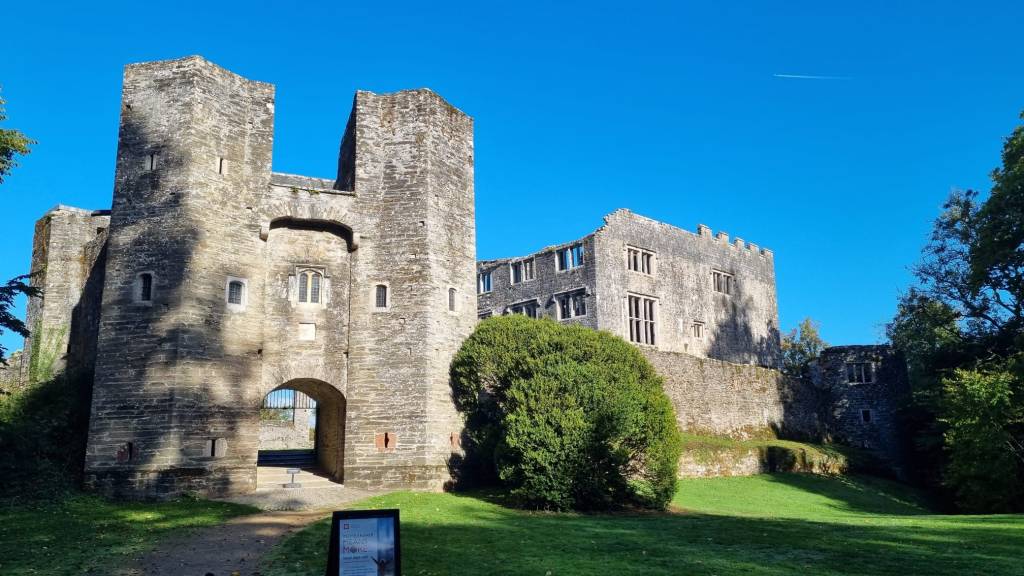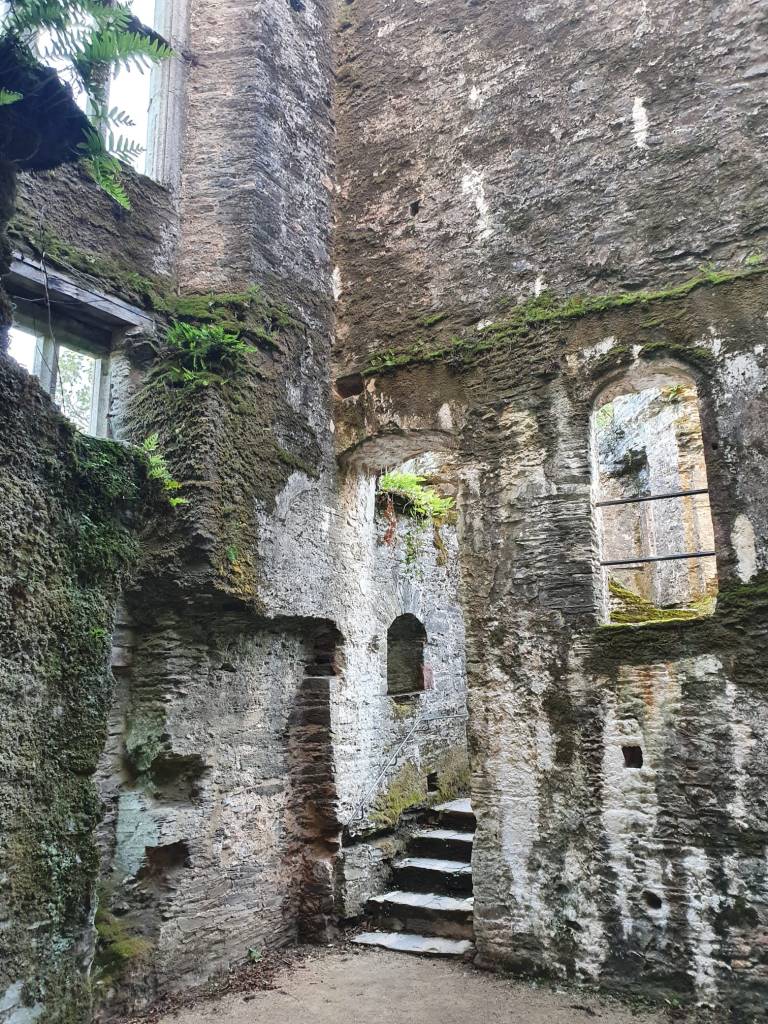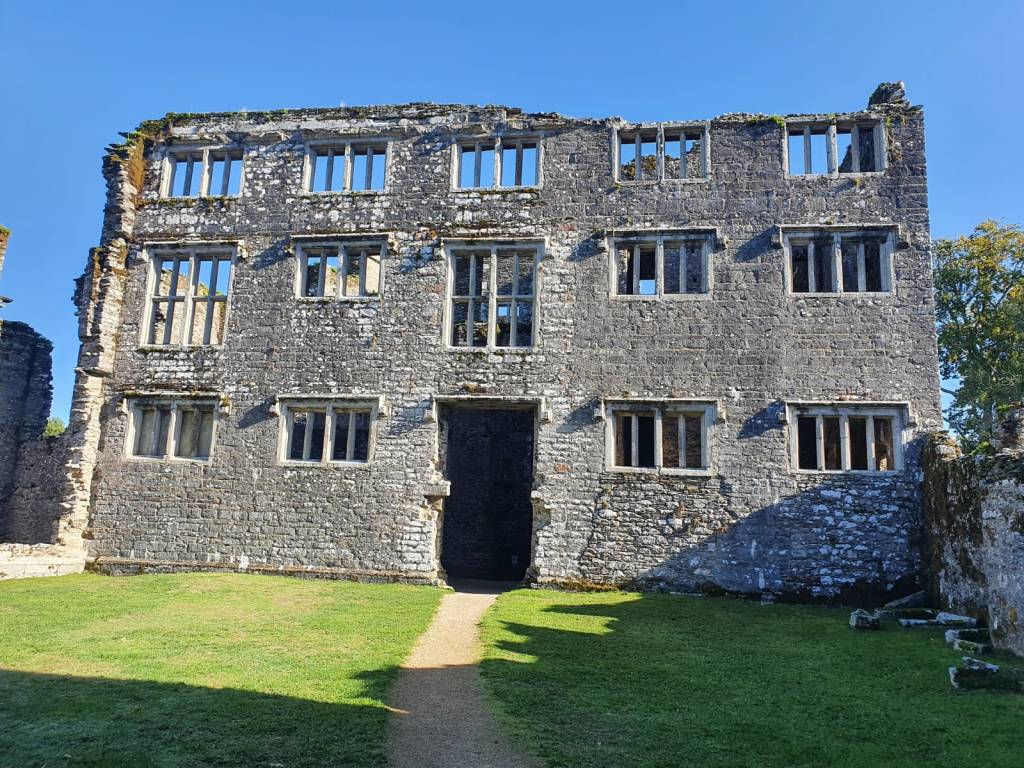In true pinned style we had the place to ourselves, the sounds of leaves rustling in the wind and footsteps around the various buildings really set the tone for an eerie experience. We take our time to walk inside to the courtyard and underneath the mighty gatehouse. History of the castle begins with the Norman Conquest of England in the 11th century, people have settled on the land at Berry Pomeroy and its surrounding countryside where The area is rich in history and full of ruins.
There have been only two families that owned the site since 1069, they were the Pomeroy’s and the Seymour’s. The very first structure on the castle site dates back to the 13th century. Although this was not a proper castle but a manor house. It wasn’t until later in the 16th century that the Pomeroy family rebuilt a medieval manor on the same site but in a form of a defensible castle that made berry Pomeroy one of the last private castles to be built in England.

Although the castle had soldiers and many fortifications, its position at the top of a steep hill meant that it was never likely to be attacked. From the 1600s onwards, ambitious extensions to the property began, the family had grand ideas and ultimately wanted the castle to end up as the largest and best stately home in the Devon area. Despite the abandoned works of the early seventeenth century, the Seymour’s continued to use Berry Pomeroy as their main residence. They supported the Royalists during the Civil War but the castle was never garrisoned and saw no action; it accordingly avoided demolition or slighting at the end of the conflict. Being far from surrounding towns the castle was too remote to be of any use to anyone. So today the ruins are run by the English heritage but still owned by the Seymour family.
The castle is built around a central courtyard, with a gatehouse and a trio of towers connected by a curtain wall. The corner towers and gatehouse all have gun ports at the ground floor level, aimed to create a continuous line of fire down the dry moat. This was the first room we were drawn into and we take a moment to Look around at the exposed beams of a rebuilt timber roof, a model of the castle and also what’s thought to be used as the castles chapel.

Around the gatehouse chamber in 1978 a late medieval painting was rediscovered by a worker of the castle, depicting a scene of the adoration of the magi, the painting is in the Flemish style and you can see the outlines in red and parts of the image, its housed on the wall of which may have once been a small corner chapel, where there is evidence of possible altar fixings on the window opening and the arches and pillars are constructed from granite. You’ll need to come here to enjoy and see the painting up close, but it’s been gated off to be preserved from some of the castle’s residents, a species of rare bats that occupy the gatehouse.
Off the gatehouse rooms you’re able to walk the chamber passages and down to the basement armaments, but above us are the remains of the second floor guardrooms, where the winding machinery for the portcullis was, this spiked iron grill could be used to drop and crush incoming attackers in a moment’s notice. On a personal note, whilst walking down this long white washed passage I felt something strange in the air, brushing it off as nothing but I can imagine being alone here in the evening or at night would be so strange and unnerving.


Onto the late 15th century curtain wall built at a time when Devon was the most lawless area in southern England, this wall walk had constant surveillance, with guards walking the entire castle perimeter via this wall, it would have surrounded the castle but the taller buildings behind us wouldn’t have actually existed back when the wall was built. A spooky encounter reads that one of these guards has been seen roaming these walls at night, pacing up and down as if he’s still on duty and another sighting of one of the guards staring out of the slit holes on the front of the gatehouse.
Our next stop is said to be the most haunted part of the castle, this was St. Margaret’s tower. The story follows that Margaret Pomeroy, sister of Eleanor Pomeroy was locked inside in the basement below by her sister after discovering that they were both in love with the same man and she was jealous of her siblings beauty, in a fit of rage the sister made sure Margaret wouldn’t see the light of day again and had her starve to death. They say that even in broad daylight you can still hear the whispers and the cries of Margaret and a sense of coldness fills the air.
She is also known as the White Lady, this restless soul haunts the basement of the Tower and has been seen waving to visitors on the dimly lit stairwell that led once to her eternal prison cell. Make of this what you will, the once basement and cell was actually the bottom of the gun emplacement covering the approach from the south. Another tragic story is the sightings of the Blue Lady. Locals believe that the Blue Lady was the daughter of a Norman lord, who killed her child having conceived it with her father. Apparently, the Blue Lady appears in the window of the highest tower, beckoning to passers-by attempting to lure them inside. Those that are foolish enough to go looking for her are said to fall to their death from the tower.


In 1537 the castle was purchased by Edward Seymour, Duke of Somerset and Lord Protector to Edward VI. He launched an ambitious project to create a Renaissance mansion overlooking the valley. But Somerset was executed for treason in 1552 and it was left to his son, also named Edward Seymour, to complete his father’s vision, but on a much less grandiose scale. This he did, and he lived here from 1575-1593. The remains of Lord Seymour’s mansion still stand to a height of four storeys and give some idea of just how grand and impressive the mansion would have been when finished. I love to see the large fireplaces and windows trailing up and down this four storied manor, we walk from the Later kitchen, through to the store rooms and around the pantry and buttery before looking around the east range inside the mansion. It’s truly incredible to imagine how many rooms would have been lived in, lit up by the fires and filled with people showing off their wealth or just enjoying life in the medieval times with their family and friends.
The mansion contained two floors of accommodation and two floors containing the hall and services. It was one of the first hunting style lodges that was built and became very popular around this time. This room was the Elizabethan great hall and you can see why with the size of the place, but this was a building where the family could join together and put on a real royal feast with entertainment and the works. Although the stone walls seem cold and bare, they would have once had the appearance of beautiful coloured walls, rich paintings and many different relics to the family’s name. In the 1560s, they erected an Elizabethan mansion within the castle’s defences.
Inside the north range are where the parlour and great chamber are and on the ground floor was the parlour room, this room was a residence where the family could sit and play games or have informal meals. It’s incredible to see the illustrations here and worth looking out for to see what it may have looked like back in the 1600’s. The walls would have been plastered with the finest tapestries and the ceiling with a richly moulded plaster patterns, this in itself would have been wonderful to have for the more lavish living. The great chamber was above the parlour and was the more striking room in the house. This was a place where Edward Seymour would have held his formal dinners for only the very important with entertainment and dancing that followed.


Similar in style with the parlour and great chamber we visited, the style of the new great hall and its decoration was very much elegant and stylish. It was elaborately decorated with many beautiful paintings and wooden panelling. The walls in this building were more glass than stone. The hall was again on ground floor level but this one was used more for the staff and the help rather than the family or important visitors. The lord of the castle’s family would normally dine elsewhere in the castle more than likely in their own private rooms that were upstairs.
Above this great hall was the long gallery, this was around 63 full metres in length and was a place where the family could show off their wealth and their stunning paintings as well as a place for the family in winter to take up activities in comfort, some of those activities included sewing and embroidery, or they could simply relax, smoke their tobacco pipes, which was heavily popular at Berry as they adopted it as a fashion statement, but they would be able to smoke these whilst looking out on to the beautiful views around the deer park and beyond.


A stunning part of the castle was onto the Jacobean range and along the passageway to the kitchen bakery and pantry range, what’s particularly striking about this is the two very large fireplaces and the variety of stone work. Building on the Jacobean range started in the 1600’s with a huge team of masons who designed the kitchens and the extensive apartments on classical designs. Many of those masons left their initials and marks on the stonework, it would have been a very noisy place with all the works going on and unfortunately Edward ran out of money and the work ceased before his death in 1613. Even incomplete, this home was still one of the finest in that era. Work was abandoned and it’s what we see and enjoy today.

Berry Pomeroy castle completely exceeded all my expectations, from the feeling you get from wandering the ruins, to the architecture and all the incredible parts of this castle still surviving. There is a nice walk around the woodlands and a trail which is signposted at the free car park just minutes walk from the castle’s shop and entrance and it’s one of those places I feel you have to visit. Whether you are into the paranormal or into our history, this castle really does have it all.
If you liked the blog please hit that like button, watch the full video below and consider subscribing if you haven’t already.
Till Next Time!
Discover more from Pinned on Places
Subscribe to get the latest posts sent to your email.


I’ve never come across Berry Pomeroy Castle before, but it looks like a fabulous castle to visit with lots of nooks and crannies to explore. Thanks for the tour!
LikeLiked by 1 person
Haunted, atmospheric, and beautiful. Such a great place to visit! 😊
LikeLiked by 1 person